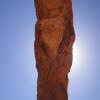I am a recent graduate and have been looking all around for jobs in my field for the past year with no avail. After coming back from PAX Prime this year, it hit me: Why don't I try and do what I enjoy and not what others want me to do? Sounds like a good plan right? The thing is, my degree is not in programming... or electrical engineering... or anything really related to the video game field. It is in Geology. Don't get me wrong, I love love love love love gaming, but rocks are pretty high up there too.
After thinking about it, it occurred to me that many games don't get the science correct when it comes to the sciences, specifically the geological sciences. The more and more I play through open world games like Skyrim or even something as simple as Minecaft, some things just don't make sense through my eyes. I want to take the map of Oblivion, and create a geologic map, create a crossection of the land, make up a story of how it was created, but in many ways, I can not, and it always bugs me.
This is me, trying to get the word out there, trying to link the geologic sciences to gaming community, because it is indeed a beautiful thing when it comes down to it. I don't know how to even approach the idea of creating a scientifically accurate game when it comes to geology... I was hoping this is where some of you guys could jump in. Perhaps, some day, I could even become a scientific advisor for some right-minded video game developer out there... who knows?
Thanks for reading, and I hope this gets to the eyes of someone that appreciates it.
~~Disc07







